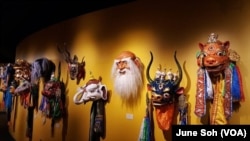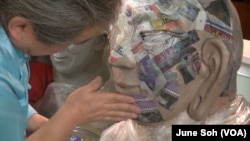When Gankhuyag Natsag makes one of his famous masks, he spends a lot of time thinking.
“During that time I am thinking that it’s all based on Buddhist philosophy. It allows for meditation, inspiration and a peaceful life,” he says.
The renowned Mongolian mask maker, known as Ganna, makes the elaborate representations of characters that appear in traditional Buddhist temple dances.
It did not get to Mongolia until 1811 and there it flourished until the Soviets cracked down on religion in Mongolia in the 1930’s.
“They destroyed more than 800 temples, including many Buddhist objects. A lot of masks were destroyed during that time,” Ganna says.
Aterwards, only about 30 masks survived. Knowing that has contributed to Ganna’s devotion to the masks. Many of the ones he makes go directly to museums around the world.
Over a ten-year period ending in 2007, Ganna lovingly made all 108 Khuree Tsam as the masks are called.
“The last mask I made was the Red Makhagala, also named Jamsran. He is the protector,” Ganna displays his work with reverence. “The other mask was the blue, bull mask. We call him Damdinchoijoo, the god of death.”
His favorite is still the first one he made, the Old White Man, Chaganb Ebugan. The Old White Man has a lot of wisdom to offer people.
Ganna has performed the Old White Man in traditional dances with the music and dance ensemble he started called Khan Bogd. The group has performed in more than 50 countries at festivals, theaters and museums.
“When I wear that mask, I become completely taken over by the role. I feel as if I am bringing people education and giving long life. In Mongolia, we respect the oldest. The oldest has to educate the younger generation.”
Inner peace, outer peace
Gankhuyag Natsag was born in Ulaanbaatar, the capital of Mongolia and immigrated to the U.S in 2002.He now lives in Arlington, Virginia where there is a big Mongolian community.
He has been making Buddhist ritual dance masks for more than two decades.
While Ganna recreated the masks, his family and friends helped him by reproducing the mask’s costumes and elaborate ornaments.
“My mother was a famous seamstress and my father was also a very artistic person. I learned a lot from them. I also studied art in school,” he says.
It takes a month for him to actually create a mask using clay and layers of papier-mache.
As much as Ganna loves the process, he also has a greater goal in mind.
“I would like to introduce Mongolian culture all over the world, through my art and through my masks. That's one of my biggest goals. We need to preserve our culture. That is very important."
Ganna has a dream project called the World Peace Pagoda. He hopes to build large scale peace education centers, one in Mongolia and another outside Washington.
"If people are peaceful and enjoyable on the inside, our outer world will directly be the same. Our world will be peaceful. That is based on the Buddhist philosophy,” Ganna maintains. “Our world is unique, it is our only home."








